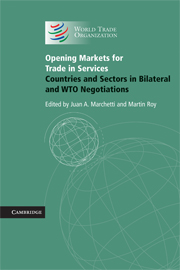Book contents
- Frontmatter
- Contents
- List of figures
- List of tables
- List of boxes
- List of contributors
- Foreword
- Acknowledgments
- Disclaimer
- Summary and overview
- PART I From Policy to Negotiations
- PART II Multilateral and Bilateral Negotiations on Services: Overall Perspectives
- PART III Challenges, Issues and Opportunities in Services Sectors
- PART IV Country Experiences with Services Trade
- 14 GATS plus or minus? Services commitments in comparative contexts for Colombia and Uruguay
- 15 Opening services markets at the regional level under the CAFTA-DR: the cases of Costa Rica and the Dominican Republic
- 16 Why isn't South Africa more proactive in international services negotiations?
- 17 Services liberalization in PTAs and the WTO: the experiences of India and Singapore
- 18 The domestic dynamics of preferential services liberalization: the experience of Australia and Thailand
- 19 The Chilean experience in services negotiations
- Appendix: A reader's guide to basic GATS concepts and negotiations
- Index
- References
18 - The domestic dynamics of preferential services liberalization: the experience of Australia and Thailand
Published online by Cambridge University Press: 05 December 2011
- Frontmatter
- Contents
- List of figures
- List of tables
- List of boxes
- List of contributors
- Foreword
- Acknowledgments
- Disclaimer
- Summary and overview
- PART I From Policy to Negotiations
- PART II Multilateral and Bilateral Negotiations on Services: Overall Perspectives
- PART III Challenges, Issues and Opportunities in Services Sectors
- PART IV Country Experiences with Services Trade
- 14 GATS plus or minus? Services commitments in comparative contexts for Colombia and Uruguay
- 15 Opening services markets at the regional level under the CAFTA-DR: the cases of Costa Rica and the Dominican Republic
- 16 Why isn't South Africa more proactive in international services negotiations?
- 17 Services liberalization in PTAs and the WTO: the experiences of India and Singapore
- 18 The domestic dynamics of preferential services liberalization: the experience of Australia and Thailand
- 19 The Chilean experience in services negotiations
- Appendix: A reader's guide to basic GATS concepts and negotiations
- Index
- References
Summary
Both Australia and Thailand have keenly pursued bilateral preferential trading agreements in recent years. These have covered services, though to varying degrees. Services, domestically important and in some areas sensitive to both economies, need to be liberalized as an important means of improving overall productivity and economic performance.
Given its development status, Thailand has been somewhat reserved in opening key sectors, such as distribution and financial services, in part due to the adverse effects of the Asian financial crisis. Consequently, liberalization has occurred largely on an ad hoc basis, either as default or as a “last resort” strategy when the situation was considered to have deteriorated so much that changes were seen as necessary. Australia is keen to develop key services exports, such as education, financial services, and telecommunications. On the other hand, like various developed countries, it is more cautious regarding mode 4 (the temporary movement of people), an area in which Thailand and some other developing countries consider they have a comparative advantage and export potential.
This chapter examines the bilateral and multilateral commitments of Australia and Thailand, and attempts to identify the underlying economic and political economy factors that help explain why different outcomes have been achieved (or not) in various negotiating contexts, including through unilateral liberalization. In doing so, it addresses the extent to which the GATS and PTAs have liberalized services in these countries.
- Type
- Chapter
- Information
- Opening Markets for Trade in ServicesCountries and Sectors in Bilateral and WTO Negotiations, pp. 633 - 666Publisher: Cambridge University PressPrint publication year: 2009



